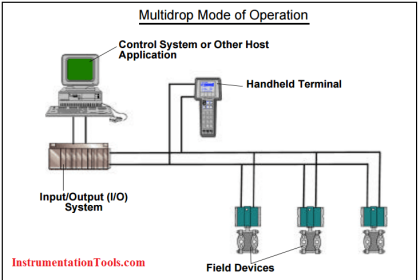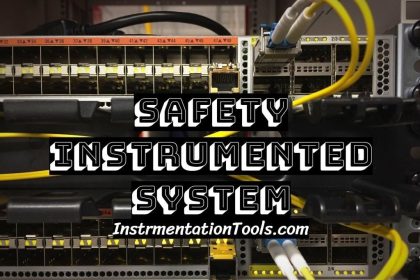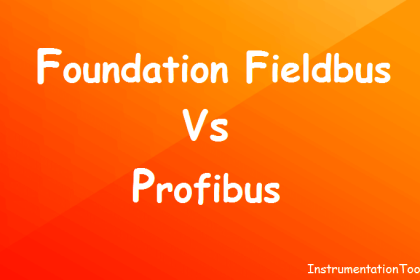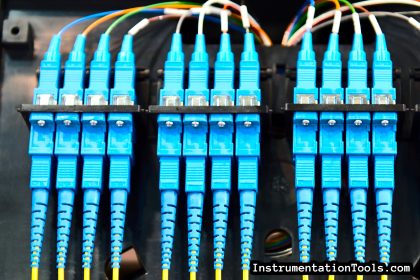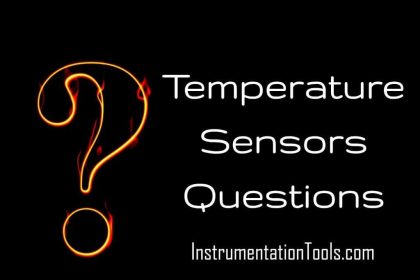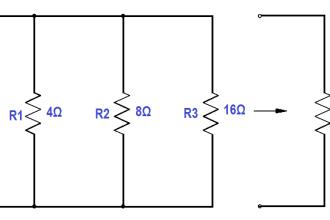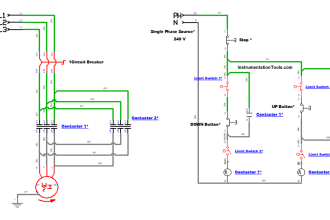Read the Foundation fieldbus interview questions and answers for your preparation.
Foundation Fieldbus Interview Questions and Answers
Foundation Fieldbus
What is FOUNDATION™ fieldbus (FF) technology?
The FOUNDATION™ fieldbus solution is a systemic technology comprised of a bi-directional communications protocol used for communications among field devices and to the control system.
It uses a Function Block structure for true distributed control and Device Description (DD) technology for parameterisation and integration of data via a network hierarchy for subsystem integration and a well-defined system management structure for reliability and determinism of functional execution.
Are there registered FF devices?
Yes. The Fieldbus Foundation registers a wide range of FF-compliant products from transmitters and meters to valve positioners, actuators, controllers and linking devices.
These products are available from a wide variety of the world′s leading automation equipment suppliers. The online product catalogue (www.fieldbus.org) gives registered device information including which standard blocks were tested for interoperability, the presence of untested Function Blocks (if any) and additional useful information about the device.
What is FF H1?
The H1 Fieldbus is a bi-directional communications protocol used for communications among field devices and to the control system.
What are the benefits of Fieldbus?
From a business viewpoint FF technology delivers savings in total installation costs. H1 Fieldbus reduces instrument wiring which in turn means less termination and fewer screwdriver turns.
The technology reduces hardware requirements and lowers capital expenditures (CAPEX) whilst it also reduces operating expenses (OPEX) through improved plant efficiencies, better asset management and reduced maintenance requirements.
Specific benefits of Fieldbus technologies include reduced wiring; multi-variable information via a single multi-channel field instrument; simpler integration and easier maintenance.
Ultimately, Fieldbus technology will be the key to greater manufacturing flexibility and productivity, higher quality products and improved regulatory compliance. This can be achieved by predictive maintenance scheduling and better upkeep via the embedded diagnostics, performance analysis data and operational statistics.
Properly adjusted and calibrated devices ensure lower process variability and higher plant availability.
The isochronous bus cycle enables tighter loop tuning and as a result, better process control. Firmware download gives the ability to stave off obsolescence, giving Fieldbus plants longer life than other plants, with greater ease.
How is FOUNDATION H1 unique?
FF H1 is the only digital Fieldbus protocol developed to fully meet with the original IEC 61158 requirements.
Unlike other protocols, H1 provides explicit synchronisation of control and communication for precisely periodic (isochronous) communication and execution of control functions with minimised dead time and jitter.
It synchronises clocks in Fieldbus devices for support of Function Block scheduling and alarm time-stamping at the point of detection.
Additionally, H1 provides automatic address setting, eliminating the need to manually set addresses off-line using a tool or DIP switches and avoiding subsequent mistakes.
H1 also uses peer-to-peer communication where devices communicate directly using a publisher/subscriber communication relationship, enabling data to be sent to several devices in a single message and thus reducing system overhead.
H1 includes alarm and event reporting for efficient diagnostics and process alarms, whilst online firmware downloads make it possible to upgrade devices in order to stay ahead of the obsolescence curve. Lastly, a rigorous interoperability-testing program ensures connectivity problems are minimised.
Is FOUNDATION H1 easier to use than traditional technology?
H1 has made it possible to “mine” important information from the plant floor. When used correctly, this information empowers operators and technicians to make plant operation and maintenance easier.
Some end users report commissioning time savings as high as 75% compared with conventional analogue technology by switching to Fieldbus technology.
FOUNDATION technology enables improved asset management using device management software, as many failures can be predicted and faults can be diagnosed in detail.
Together, device management software and Fieldbus devices typically enable:
- Identification & information
- Diagnostics, performance analysis & operational statistics
- Parameterisation, ranging, reconciliation & audit trail
- Simulation & override
- Calibration trim & log
- Document access
- Device event capture & monitoring
- Commissioning
- Maintenance log & service notes
- Device listing
- Maintenance & calibration scheduling
How does H1 “Fieldbus” differ from the various device-level networks now in use?
H1 was designed specifically for process automation. It differs significantly from device-level networks for factory automation in its ability to provide intrinsically safe power for field devices used in hazardous locations.
Moreover, thanks to scheduling, H1 Fieldbus is isochronous, which is a requirement for continuous regulatory process control.
H1 was designed and developed as a system technology providing significantly more structure and benefit than mere communication networks.
H1 technology delivers true distributed control networking and provides asset optimisation through a broad range of diagnostic capabilities and consistent data structures through the use of Electronic Device Description Language (EDDL).
FF technology also provides easy and extensive integration capabilities through open and consistent integration to HSE in a single engineering environment.
Device-level networks without power and intrinsic safety (and no scheduling) are mostly appropriate for on/off components with limited data and for dedicated applications such as machine control.
What is FOUNDATION HSE?
FOUNDATION High Speed Ethernet (HSE) is a control network technology specifically designed for process automation to connect higher-level devices such as controllers and remote-I/O, high-density data generators etc., and for horizontal integration of subsystems.
What are the benefits of HSE?
FOUNDATION HSE enjoys a fully fledged redundancy scheme giving control systems greater availability than systems using simple ring-topology.
Use of unmodified Ethernet and standard IP makes HSE systems more cost-effective than other Ethernet solutions and proprietary networks.
Since HSE is a standard, it enables simple and tight integration between package units and the main control system. The HSE network is easier and cheaper to manage based on common network knowledge and standard SNMP tools.
How is FOUNDATION HSE unique?
FOUNDATION HSE is based on unmodified IEEE 802.3 Ethernet and is therefore compatible with standard Ethernet equipment.
Unlike “ring topology”FOUNDATION HSE provides complete “DCS style” redundancy with redundant network switches, redundant devices and redundant communication ports ensuring unsurpassed availability.
FOUNDATION HSE is also based on standard IP, enabling it to coexist with other devices and ensuring compatibility with standard tools.
At the highest level, FOUNDATION HSE includes a standard application layer that provides interoperability between devices beyond the mere coexistence provided by Ethernet and TCP/IP.
FOUNDATION HSE communication is schedule-driven to minimise dead-time and jitter with support for peer-to-peer communication directly between devices. Again, a rigorous interoperability testing program ensures minimum connectivity issues.
Is FOUNDATION HSE easier to use than RS485 and coax-based networks?
The hub-and-spoke tree topology of Ethernet makes it very easy to add and remove devices without upsetting the operating network.
Because FOUNDATION HSE is based on unmodified Ethernet, standard Ethernet tools can be used for installation qualification, testing and troubleshooting.
These tools speed up the resolution of communication problems. FOUNDATION HSE is supported by troubleshooting tools that are not available for RS485 or coax, and since FOUNDATION HSE is based on UDP and TCP, standard network management tools employing SNMP, RMON, etc., can also be used. Similarly, familiar IP addressing is used including support for DHCP.
What makes FOUNDATION devices interoperable?
Interoperability is made possible by the fact that devices and software are conforming to the same standard.
Testing and registration ensures that Fieldbus devices bearing the official “checkmark” seal can be connected on the same bus or network and exchange information without significant integration effort.
End users can select the best device for a specific measurement or control task, regardless of the manufacturer.
How is interoperability defined in relation to FOUNDATION technology?
Interoperability refers to the ability of any ITK-registered device to work with any HIST-analysed host.
Users want to operate their entire plant from one operator interface and maintain all devices on the system with one maintenance application.
Are Fieldbus devices interchangeable?
Yes. End users can substitute a registered Fieldbus device from one manufacturer with that of another manufacturer on their network without loss of degree of integration.
What types of projects are appropriate for Fieldbus technology?
Fieldbus technology is now being utilised on automation projects of all sizes, including both new and retrofit installations. According to an ARC Advisory Group survey, a significant number of end users are installing small, medium and even very large Fieldbus systems consisting of over 2,000 I/O points.
Shell, a major adopter of FF technology, reportedly has over 120,000 installed Fieldbus I/O with 31% of these devices replacing conventional instruments.
What applications are best suited to Fieldbus?
Both H1 and HSE were specifically designed for process control. Because H1 and HSE have complementary characteristics covering diverse networking needs, Fiedlbus technology is appropriate for many applications.
These include closed-loop continuous control, batch sequencing, remote-I/O and legacy system integration.
The Fieldbus Foundation′s Safety Instrumented Systems (SIS) specification includes an additional safety layer based on IEC 61508 requirements, making it suitable for use in plant safety systems.
How do end users influence the direction of the technology?
The Fieldbus Foundation established an End User Advisory Council (EUAC) to give end users a voice in the direction of its technology.
The group meets two to three times per year to discuss issues involving their specific plants and industries.
Is Fieldbus an open technology available to all suppliers and end users?
Yes. A key tenet of both the Fieldbus Foundation and PROFIBUS protocols is that they are non-proprietary and available to all companies wishing to include it in their product offerings.
Both the H1 Fieldbus and the HSE control network are part of the IEC 61158 protocol standard and IEC 61784 profile.
Does FF technology allow traditional centralised control to be located in the DCS?
Yes. FF technology provides end users with the freedom to locate control in the control system or in the field devices.
The Fieldbus Foundation does not advocate a particular control strategy.
How does FF solve the business needs of enterprise automation applications?
FOUNDATION HSE enables information from intelligent devices to pass through control systems without loss, degradation or the delay associated with proprietary control networks to device management software.
It also allows the possibility of electronic integration with higher-level MIS and ERP applications.
How does FOUNDATION technology handle discrete I/O?
Fieldbus Foundation members provide a variety of discrete devices for mini remote I/O, relay, on/off valves, valve couplers, electric actuators, etc., on H1 as well as large remote I/O on HSE. Indeed, on/off signals in bulk are an integral part of the FOUNDATION solution. The technology is well suited for hybrid control.
Is FF technology a recognised international standard?
The IEC voted to include the FOUNDATION HI and HSE specifications in the IEC 61158 international Fieldbus standard. The CENELEC Technical Bureau added the FOUNDATION H1 specifications to EN 50170, the Fieldbus Euronorm. In addition, FOUNDATION technology is the only implementation of the ANSI/ISA-50.02 standard.
Both NAMUR (Germany) and JEMIMA (Japan) have voiced support for FOUNDATION technology, and provided input from the end user community that aided in specification development.
Approval and support by key international industry bodies gives confidence to users that their investments in FOUNDATION solutions are based on recognised global standards.
What are the most common Fieldbus wiring errors?
There are two very common wiring errors that will cause operational difficulty if not remedied. The first is a short from the shield to one of the Fieldbus conductors.
Although this may not immediately cause communication errors, it ground references (since the shield is grounded) the Fieldbus pair and makes it much more susceptible to electrical interference.
The second most common problem is an incorrect number of Terminators. There should be two and only two Terminators on each Fieldbus segment.
Since the Fieldbus installation will likely be installed by contractors who are unfamiliar with Fieldbus, we recommend a Segment Checkout Procedure BEFORE powering up or commissioning the segment.
Many host suppliers have such procedures. The Fieldbus Foundation also publishes an engineering document for Fieldbus that contains such a procedure.
How is Profibus PA different from Foundation Fieldbus?
Both Profibus PA and Foundation Fieldbus share the same Physical layer definitions.
Therefore the connection and power equipment that will work identically for both types of busses.
The difference is in the protocol. Therefore, FBT-3 Fieldbus Monitor will not work with Profibus PA as it was only designed for Foundation Fieldbus.
What is the difference between HART and Fieldbus?
That is like answering “what is the difference between a bicycle tire and a car?” HART is only meant for communication protocol, whereas Fieldbus is actually a system architecture including control strategy etc.
Not merely better, but radically different. Indeed, mistaking Fieldbus for a “digital 4-20 mA” or a better DCS is like mistaking the computer for a better typewriter. It cannot even be compared to “smart” transmitter protocols.
Imagine for a moment:
A system that renders obsolete all separate signal conditioners, isolation amplifiers, input cards, output cards, CPU cards, I/P converters, and their web of interconnecting wires, almost an entire DCS.
A system completely self-contained; expressed simply as field devices and a man-machine interface (MMI) like an operator console.
A system where all controls, alarms, computation, selection, Totalization and much more – performed by the field devices’ microprocessors. A system so powerful it may overcome a process’ controls problems with a few clicks of a mouse.
Fieldbus is the ultimate. The signal transmission has evolved to completely digital, system architecture has evolved to completely distributed to the field. I.e. Fieldbus not only replaces 4-20 mA, but also the by now hopelessly outdated DCS architecture of the seventies.
What are the benefits of Fieldbus?
The benefits of Fieldbus are many and some were already described;
- Lower cost of purchase and ownership;
- Productivity and quality increase;
- Higher integrity and accuracy;
- Access to more information and diagnosis;
- Easier installation and start-up;
- Freedom of component choice;
- Easier to configure;
- Easy for having single consistent database;
How does Fieldbus lower the cost?
Economic benefits spring mainly from the fact that less hardware is required. Of the expensive DCS only the operator console remains. Due to its non-critical nature, a PC or IPC (Industrially hardened PC) with off the shelf software may be used, even for large systems.
Fieldbus devices may perform multiple measurements, control and computations. The number of transmitters may be reduced, single loop controller and computational units will not be required, again saving cost.
Though Fieldbus, the device price may initially be higher than conventional or smart, the reduction in devices and wiring with associated cable trays and marshalling boxes will make the system cheaper. Manufacturers can no longer rely on proprietary technology to keep prices up. Open competition enabled by a playing field levelled by Fieldbus will reduce prices.
Cost is not only price… There are substantial long-term savings resulting from the increased information flow in terms of diagnostic information and easier calibration etc.
Many Fieldbus transmitters will be of a multiple variable type. For example, dual channel field mounted temperature transmitters measuring two temperatures being able to transmit both variables in real time.
Since a single transmitter can condition several sensors, the cost per measurement point will be lower. This is the ideal combination of price and performance.
Previously multiple temperatures sensors where typically handled by conditioners in the control room with long wires into the field, having a penalty on accuracy and noise immunity due to factors like lead wire resistance, poor or no thermocouple compensation wire and poor routing of low level signals.
Multiple variable technology makes it economically viable to use field-mounted transmitters right next to the sensors for immediate interface and transmission in the high integrity digital domain.
Added advantage is the capability to perform high and low selection, redundant sensor voting, average and difference calculation in the field.
Fieldbus helps companies increase productivity, flexibility, quality and comply with ever more stringent environmental regulations, and at the same time lower their operating cost. Fieldbus is the means whereby companies will stay competitive well into the 21st century.
What is all this diagnostics stuff in fieldbus ?
The digital communication provides the means for all the device data, configuration, operation and diagnostics details to be accessed from the control room. The complete interoperability of Fieldbus enables this data to also be accessed by any software that desires to do so.
The multiple variable nature of Fieldbus also allows new innovative devices. Transmitters that measure more than one variable have built in flow and HTG computers etc.
Schemes for consistent diagnostics interrogation and failure alerts were designed into Fieldbus from the very beginning. The self-diagnostics of field devices may report failures and problems immediately, enabling maintenance personnel to pinpoint errors instantly or even before they can cause any harm.
More self-diagnostics will therefore be implemented. Hardware failures like sensor, actuator and memory problems, and the operator reports all software problems like configuration or calibration errors without the need for manual interrogation.
In the event of a fault it is reported with the associated information like which device, what type of fault, priority and the time stamp etc.
The benefit for the operator to get this information without having to bring the transmitter in to a workshop for testing is obvious. The time that can be saved by not having to test only a few transmitters is enormous.
Diagnostics enables you to quickly determine if a process problem is due to the transmitter or not, without having to do several field visits. Production can get back in operation in minutes.
All this reduces errors and makes calibration less of a choir ensuring it is done correctly and on a periodic basis. The end result is a better measurement and improved quality.
What is a transducer block?
This blocks interfaces the function block to the device hardware such as sensors, actuators and switches.
This block is responsible for information and functionality specific to for example the measurement of a particular physical property, such as pressure or temperature, or a specific measurement technology, such as ultrasonic or Coriolis.
The transducer blocks interface to the function blocks over hardware channel, which is different from function block links. Transducer block handle not only measurement, but also actuation and display.
What is a resource block?
The resource block contains information which is common to the whole resource, including device identification, hardware, device features, memory and CPU availability, write protection, management of failsafe and alarms.
The data is not processed in this block, so there is no block algorithm.
What is automatic alarm notification?
Alarms and events are jointly referred to as Alerts. The function blocks into the devices detect alarms. When alarms and other critical events occur, the function block automatically notifies the MMI by sending an Alert.
The MMI confirms receipt of alert notification to the field device. If the field device does not receive the confirmation, it will re-send the notification.
Alerts are also issued when alarm conditions disappear. Thus the operator interface does not have to perform periodic polling to determine if there is an alarm condition, and surely any alarm can be detected. Information in the notification includes time and priority.
The current status of alarms and events may also be checked at any time from alarm and event parameters in each block.
How does distributed trending work?
The device may do trending itself. This way periodic time critical communication is not necessary.
A MMI only needs to poll a device for data when a particular parameter is displayed on the screen. When the parameter is not displayed, polling need not be done.
A set of data, 16 samples, is collected over a short, user configurable, period of time and is then automatically sent in a single communication to the MMI where the long-term storage is done.
What is a device description?
Since profiles offers choices to what capabilities and parameters are implemented in a device, a configuration device or other MMI need to know which of these a particular device implements.
The device description (DD) specifies which application area and device profile a device belongs to. For certain parameters it also specifies options are valid and more specific meanings etc.
DD may also define methods, e.g. for steps a Host to follow when calibrating the device. The DD file also can describe an user group or vendor specific features on these devices.
The DD is prepared by the device manufacturer and may either be stored in the device itself or be supplied separately, e.g. on a floppy disk or CD-ROM.
A MMI may using the DD completely and correctly configure a new device or new version of a device without a corresponding upgrade.
What are the distinguishing features of a “true” Fieldbus, delivering the original promise?
The main characteristics of Fieldbus are:
- Completely digital replacement of 4-20 mA;
- Control, alarm, computation and other functions distributed to devices in the field;
- Multi-vendor interoperable through open specification;
- Specifically designed for process control;
- DCS/smart-transmitter and other protocols calling themselves Fieldbus do not show these characteristics;
What is the benefit of being completely digital?
Unlike the “semi digital” DCS system, the Fieldbus system is a “pure digital” system.
Instead of the system’s pressure or temperature transmitters converting a sensed digital process value to an analog 4-20 mA signal before feeding it to the DCS and the rest of the system chain, Fieldbus keeps the signal purely digital all the way from the transmitter to the digital input of the control valve.
Fieldbus devices should not be mixed up with what we today call smart devices which are a hybrid of 4-20 mA and slow digital communication.
Keeping the signal digital until the very end of the chain allows for infinitely more complex and precise signal processing. And the industry standard, inexpensive cable that links all the Fieldbus components together can be hundreds of meters long and remain totally free of the noise pickup and signal degradation associated with analogue signal transmission.
In a 4-20 mA analog system, a single value is transmitted by an infinite variation of a current. A signal error just changes a valid signal to another valid signal, noise and other signal distortion cannot be detected in an analog system.
The signal from even the most accurate analog transmitter may be totally inaccurate by the time it reaches the controller. Much more noise is required to distort a digital signal such as in Fieldbus, which only has two valid states, one and zero.
Secondly, error checking is also used to filter out scrambled messages and make sure they are sent again. All data is checked and guaranteed free from distortion due to noise or impedance mismatch that may affect analog signals undetected.
Each analogue link – transmitter, signal conditioner, isolation amplifier, cable, input card, output card, I/P converter – whispers an ‘analogy’ of what it hears to the next, but something is always lost or added.
What emerges at the end may not even resemble the original message. No matter how long the chain, at its end digital equipment listens only for patterns of zero and one, which it reassembles into the original message, ignoring all other whispered information as noise. Hence the integrity of digital transmission: no accuracy lost, any noise added.
The integrity of a digital signalling results in better accuracy and security. The latter is being very important in the process industry where expensive equipment, life and the environment may be at stake.
Fieldbus has taken this integrity even further. Measurement and control variables passed between function blocks have not only a value, but also a status, which include signal quality, limit information and a sub-status.
The signal quality informs if e.g. a measurement is Good, totally Bad or perhaps Uncertain, e.g. out of range by a few percent.
Other function blocks use this to e.g. put control in manual in case of fault, calculation function blocks may also take this information into consideration, e.g. exclude it when calculating an average.
How is Fieldbus more distributed than a “Distributed Control System”?
Unlike the “semi-distributed” DCS system, the Fieldbus system is a completely distributed.
In Fieldbus the process control functions are distributed to equipment in the field, while still allowing operation and tuning from the control room using the digital communication.
The field devices are typically multi-dropped, several connected to each other and the operator console, drastically reducing wiring with subsequent savings in cost of purchase and installation.
In the legacy DCS of the 1970 the control functions for several loops was centralized to one or more “unit controllers” which contains control, input and output cards.
Since in Fieldbus communication is completely digital no input or output cards are required, and since the control functions are performed by the devices in the field, no control cards are required either.
Field devices may be connected directly to the operator console, hence a data highway connecting control cards is not required either. Since there are no cards and no data highway, they need not be made redundant either.
All that remains of the classic DCS architecture is the field devices and the operator console. Obviously a Fieldbus system means a tremendous hardware and subsequent cost reduction.
Will Fieldbus replace DCS as we know it?
Yes. Some companies have a vested interest in saying that it won’t, but with Fieldbus there is no need for analog and digital input cards (since communication is already digital) and there is no need for any controller “CPU” cards (since control is done in the field devices), nor is a “data high way” required to link the system together. All that will remain is the operator console. Ask yourself, is that a DCS as we know it?
The first DCS systems emerged more than twenty years ago. Though a major improvement at the time, this technology of yesteryear has many deficiencies.
Established DCS manufacturers now offering their own PC based control software, or buying out PC software companies must be seen as the final nail in the coffin for DCS.
Many control software packages for PC today have all the bells and whistles of a DCS and are available for secure and stable operating systems. These are most likely to serve as operator consoles to make complete Fieldbus systems.
Lets look at what would happen if a shortsighted customer decided to go for the legacy DCS architecture of the 1970s, and then upgrade to Fieldbus a few years later. He would most likely have to replace the entire transmitter for all measurements, wiring would have to be redone, power supplies, safety barriers and any interfaces would have to be replaced, input, output, CPU cards and “data-highway” (main and redundant) thrown away, and termination added – all that remains is the operator console. Upgradability to Fieldbus is an important consideration when choosing a control system.
What happens to data base configuration in a Fieldbus system?
Fieldbus is using the concept of a completely distributed database. Device and control loop information is encapsulated in the field device itself, ranges, tuning, wetted materials data etc.
Any MMI that desires to display that information may access it. This way there are no duplicate inconsistent databases. In DCS synchronisation between the console and device database was not guaranteed.
There was always a risk that the device was calibrated for one flow range, but the console for another giving a wrong indication.
In Fieldbus only one database exists, in the field device, and the MMI gets it scaling data from there. A hand-held configuration device accesses the same device data as the operator console.
Isn’t Fieldbus too slow, 31.25 kbit/s compared to several Mbit/s for DCS?
In Fieldbus there are typically only 12 device per segment (on a pair of wires) whereas on a DCS all the device of the entire plant are indirectly connected to a single bus which therefore must be faster.
In order to transfer all link and supervisory data fast enough to get tight closed loop control and fast MMI (Man-Machine Interface, such as an operator console) screen update, Fieldbus implements a number features for communication optimisation.
- Automatic distributed alarm detection and notification
- Distributed Trending
- Parameter view object groups
- Scheduling
- Update event notification
Thanks to the mechanisms for passing of configuration, alarm and trend data this so-called background traffic has been reduced to a minimum leaving more time for operational traffic and again improving control performance.
After configuration, the system resolves tags and parameter names into a format, which minimises communication.
What are View objects?
Block parameters have been arranged in four groups depending on usage and storage.
All parameters in a group may be accessed in a single communication. This way an MMI need not occupy the bus by several requests get the parameters one by one.
What is an update event?
An event is also a form of Alert. The MMI is automatically informed about configuration changes through an event issued by the block, which is changed, and is also tracked by a revision parameter included in the view objects.
Each time a static parameter is changed this revision parameter is incremented.
Therefore a MMI only need to update itself when a change has occurred, it does not have to make continuous checks.
What is scheduling?
Function block execution and communication is scheduled to optimise control and communication efficiency. It may be used to ensure that blocks are executed in the correct order.
The sequential passing of dynamic time critical function block input and output data is called operational traffic.
This traffic and the execution of the function blocks is scheduled by the system so as to occur on a precisely period basis with a minimum delay thereby achieving optimum closed loop control performance. Scheduling allows the user to control the order and also the frequency of execution of a block.
Without scheduling the loop dead time will most likely be longer than the time it takes to communicate the operational traffic on the Fieldbus network. Another reason is that without scheduling the blocks may be executed in the wrong order.
Is Fieldbus easy? It sounds complicated?
As the first protocol to bring the full power of microprocessor technology into field instrumentation, Fieldbus distil countless hours of thought into every aspect.
When you press a key or click to change the configuration, the effect is powerful, yet all the work has been done for you. There is no need to understand the wealth of technical strength hidden in your field device in order to appreciate it.
Fieldbus is easy to use, there is no need to understand the “layers” and “baud rate”, it has been taken care of by the best engineers from the leading companies in transmitters, systems and actuators.
Configuration becomes easier because it will be done the same way for basically all devices using the function block concept, no need for training on several device types or programming languages. All manufacturers use the same blocks, regardless if they are in a field device or not.
Fieldbus is based on user-defined tags and standardized parameter names like SP and PV. He refers to devices by its tag. The user need not think of device address, memory address and bit numbers etc. Configuration may be edited on a PC and then down loaded to the devices in the field. If you want a flow transmitter to integrate, just instantiated the function block, no need to rewire or buy an additional device.
Once physically connected, the links between function blocks may be changed, function blocks can be added and removed etc. More advanced devices may execute a virtually unlimited number of function blocks.
Procedures like calibration, range setting and diagnostics are implemented consistently between manufacturers and device types. I.e. a density and pressure transmitter from two different companies are operated in the same basic way. This reduces confusion and makes operator training easy, even though your preferred vendor for various device types is different and may change over the years.
Fieldbus already has blocks for all kinds of process control functionality like input, output, control, calculate and various types of computations forming an advanced set. Several of the blocks implement alarm. New blocks will keep getting added.
Connection is a simple task since devices are connected in parallel and terminal number matching will be a minimum. One wire will typically connect as many as twelve devices. Cable trays, conduits etc. will be drastically reduced. It also becomes easy to add devices, just hook it up in parallel, no need to run a new wire.
Fieldbus has capability to simulate input or output values or status making it possible for a single person to from the control room safely test the system response to faults and process conditions which would otherwise be difficult or dangerous to try out.
Previously making such a test was troublesome. Two persons equipped with walkie-talkies were always required, one climbing on tanks and pipes in the field with a simulator. There is no need to expose anybody to an unfriendly or hazardous environment.
“Ringing out” the transmitters, i.e. match the wires in the marshalling rack to their respective devices is also much easier, apply power and connect the Host and ask for the tag and you are done!>
Fieldbus devices store information useful for maintenance in the device, where it will never get lost. You may store a calibration data like when and by whom, description of the service of the device and even individual blocks may be stored, this could be e.g. “Level – Boiler 1”.
A wealth of information is available in the device, which also includes wetted materials information and serial numbers. This may not only be available with the Host, but also from operator console.
Accessing the device operating temperature reading allows you to see if it is operating within range. The temperature reading proves extra valuable in applications where heat tracing and winterization is used.
The temperature reading is an indication of if it is working or not, so that transmitter does not fail or pipes are clogged due to solidification.
Instrument calibration and maintenance data may be stored in the transmitter database where it, unlike if stored on paper or a disk, will not be misplaced or separated from the transmitter even if the device is moved around in the plant or even shelved.
This may include information like performed by whom, where, when, how and at what value calibration last was made. The information is not only more than seen before, the interoperability of Fieldbus makes it more accessible than seen for smart transmitters.
This instrument management is an important feature to help comply with ISO9000 and ISO14000 requirement for updated and traceable calibration records – again a tool for better sensing.
Won’t Fieldbus stifle innovation?
Since digital communication was first introduced in process control, manufacturers have been forced to adapt their products to a myriad of protocols as they emerge.
A standard Fieldbus has relieved device manufacturers from this task. Once again they can concentrate on true innovations such as sensing techniques getting higher accuracy, reliability, stability to ambient effects, and transmitters for multiple variables.
Fieldbus is a performance specification. This means product developers have maximum choice over how they implement it into products. Fieldbus device manufacturers can select from the microprocessor, programming language and methods of their choice. This can greatly streamline the product development process, and production costs.
A single common Fieldbus will spur third party software and other accessories, as the market for a given product would be larger, providing an economy of scale factor justifying product development. More software and accessories will make Fieldbus more attractive contributing to the proliferation.
Fieldbus will just be another requirement in an already long list of standards specified by instrument buyers, essential when it comes to putting the pieces of a plant together, and being able to make replacements:
- Temperature sensors;
- Process connection;
- Electrical connection;
- Calibration;
- Fieldbus;
- Cleaning for oxygen service;
- Environmental conditions testing;
- Intrinsic safety;
- Material grades;
Some have forgotten the beauty of standards and have take all the benefits of standardization for granted so much so that we even argue if they are good or not.
The question is if the industrialized society could function if it was not for the thousands of standards making it tick. Could we even imagine going back to a time where a bolt and a nut from different shops do not fit together? If they were not for standards a lot of things in our lives would not work e.g. bolts and nuts. Standardization of measures, screws etc. is the very foundation on which engineering rests.
The situation we have now when new protocols show up every day is in a way hampering development because nobody dare to chose. Lack of standardization, new protocols coming up, instrument manufacturers and control software manufacturers has been tracking a moving target.
Standards are especially in the USA criticized for stifling development. However, standards actually enables true innovation rather than just coming up with many new solutions for the same problem already solved.
Once a standard has been laid down, enough people are willing to buy products based on it providing a large enough market for new ideas based on the technology in the standard.
Manufacturers now dare to spend money developing a new product making use of the standard, knowing the standard will not change so soon.
Investing in development based on somebody else’s proprietary technology is a great risk, manufacturers at the mercy of the technology owner never know if there will be a new version out the next month rendering their development efforts useless.
As an example, the technology to make multiple variable transmitters and control and computation in the field has been around for a long time, but it has basically been pointless before Fieldbus because only with the interoperability that Fieldbus provides is it possible to make good use of it.
Also Read: Basics of Foundation Fieldbus




